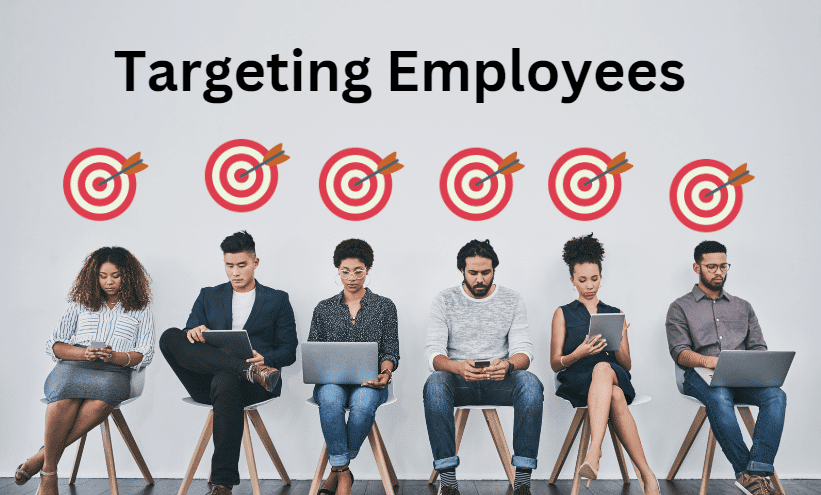More and more, companies are discovering the importance of keeping their employees engaged. For this reason, targeting employees with communication has become of paramount interest to forward-thinking organizations.
Why Engagement Via Targeting Employees Should Be an Organizational Priority for 2023
Why does loyalty matter? Employee loyalty breeds customer loyalty. According to a Gallup study, only 32% of part and full-time employees are actively engaged in their organizations. Another study found that companies with engaged employees see 233% greater customer loyalty than companies with disengaged staff. Engaged employees also contributed a 26% greater increase in annual revenue than those with disengaged employees.
Engaged employees work longer, have a better sense of top priorities for the company, and are largely more productive than disengaged employees. Most organizations have a lot of room for improvement in this area.
Another reason targeting employees for employee engagement matters is turnover. ADP Research Institute found that workers aged 24 and under had a turnover rate of 50 percent in the first quarter of 2016. And that costs companies a whopping $30.5 billion annually (2016 Employee Retention Statistics).
There are a lot of ways to engage employees on-site at the office, but businesses are also realizing that it is time to meet employees wherever they are. This is where mobile technology comes into play.
Average cell phone users touch their smartphone 2,617 times a day. Mobile is a tool that is just waiting to be used. Here are seven ways employers and their employees can benefit from mobile employee engagement.
#1 Connect with employees anytime, anywhere for targeting employees
Most people in the U.S. have mobile devices somewhere on their person for the majority of the day. If they are interacting with those devices as much as the stats say they are, employers have a built-in way to connect with employees whenever and wherever it is most convenient for the employee. Email blasts can be missed, but a push notification on an employee’s phone is going to be seen. This is great for company-wide messages, like a change in email policy or an update to the employee handbook, but it is also valuable for managers and team members.
#2 Targeting Employees For Instant Feedback
Surveys and polls are excellent tools for employers. They make workers feel like they have a voice. They are a great way to build the employer-employee relationship. If a company is looking to take the next step in instant feedback, though, it may be time to go mobile.
Geolocation technology allows employers with targeting employees and feed them a survey or poll based on the office they just left, while the experience is still fresh in their minds. Companies can also push surveys based on the content that an employee is perusing, with questions based on, for example, the video or training module the person just finished.
Again, this is good for both employers and employees. It allows the employer to enhance the experience for the next user (with real-time feedback) and it gives the employee a sense that his or her opinion is being heard.
#3 Employee Targeting to Increase Productivity
Mobile engagement allows employees to participate in work-related activities on their own time, which increases productivity. If an employee can watch a training video on the train commute home, for example, he or she is more likely to do so than if extra time must be set aside during the day.
Another way targeting employees can increase productivity is through gamification. Quizzes, trivia, augmented reality, geo-tagged scavenger hunts, and more can help encourage employees to learn faster and help keep employee enthusiasm high.
#4 Employee targeting by Incentivizing Interactivity with the Brand
Employees are even more likely to watch a training video or play a game if there is an incentive to do so, in the form of badges or points that can be redeemed for rewards. Badges can be given for any number of things such as: browsing a few screens, submitting or sharing information, or providing feedback.
This system encourages interaction with the brand, forges even stronger ties between employee and employer, and can help put employees on the fast track to advancement within the company.

#5 Enhance Personalization
Targeting employees also allows a company to create an experience targeted to fulfill the needs and desires of each employee. Depending on a user’s history with the app, what videos they tend to watch, or which surveys they choose to fill out, different content can be pushed to make their experience more valuable and enjoyable. Personalization also allows employers to learn more about their workers, which can inform future content and information.
#6 Communicate Clear Values
If a business is looking to build employee engagement and, subsequently, loyal brand ambassadors, they want their workers to understand corporate vision and values. According to a survey from Eagle Hill Consulting, 47 percent of workers do not know or are unsure of their employer’s core values.
Mobile engagement is an excellent way to communicate a company’s mission and values because the entire experience is branded. Even the decision to go mobile itself communicates something about a company.
#7 Encourage Camaraderie
An in-office chat system is very useful for communication when people are at work, but a mobile app allows employees to interact with each other outside of the office. Employees who forge relationships and connect outside of the office are more likely to work well together and increasingly likely to stay in their jobs.
The Benefits of Mobile Employee Engagement
Engaged employees do not quit easily or at the first opportunity that comes their way. They are more like brand ambassadors who spread goodwill about you and your company. Mobile engagement helps you build strong connections with employees by delivering content to them on their terms. Hence, mobile employee engagement just makes sense.
If you’re looking to take the next step in employee engagement, we can help. Try the HubEngage app for free to find out how your company can go mobile.
Frequently Asked Questions (FAQs):
1. How do you target employees?
As an HRM, you can easily find innovative ways to engage your employees and attract top talent simultaneously. Just leverage targeted mobile app engagement. This approach lures employees back into the fold. And by showcasing company developments you can make them feel valued as a part of your organization. This keeps employees informed and makes it easy for current and potential staff to access crucial information from anywhere.
2. What are some common methods for targeting employees?
Attracting and retaining the best employees is essential for any organization to remain competitive and successful. For HR professionals, understanding the different methods used to identify, target, and motivate potential job candidates can be a crucial tool in reaching organizational objectives. In this blog post, we’ll discuss some of the more common approaches used by employers today and examine how they can assist HR teams when building their workforce. From actively looking in the right places to utilizing passive strategies that tap into existing networks – there are several ways employers can optimize their search for talent while staying ahead of competitors.
3. What are the benefits of targeting employees?
In today’s competitive business landscape, it pays to make sure you are actively targeting the right employees for your company. It goes without saying that recruiting and hiring the right people can bring a number of benefits to your organization. It triggers cost savings, increased productivity, improved morale, and more. What many don’t realize is just how powerful targeted employee recruitment efforts can be when strategically implemented alongside end goals.
4. How can you improve your targeting of employees?
Recruiting the right talent for your organization is a key factor in obtaining success. Knowing how to effectively target potential employees can be a great challenge due to the increasingly diverse workforce. The job market is constantly evolving. Hence, employers must keep up with current trends to stay ahead of the competition. By carefully examining your recruitment process, you’ll gain insights into how you can improve your employee targeting program. From developing strategic performance assessment methods to achieving stronger employee retention, employee targeting can deliver results as planned. There are simple ways that HR professionals can refine their targeting of potential and current employees for maximum efficacy.
5. What are some common mistakes when targeting employees?
Employers across all industries recognize the importance of attracting and maintaining optimal levels of talented employees. Targeting potential talent can be tricky. And making even one small mistake could lead to major missed opportunities. To tap the best potential talent available, it is important that you understand the common mistakes when targeting employees. If you know it, you can avoid it.
Conclusion: Fostering a positive and engaging environment for their employees is a must for companies of all sizes
By prioritizing employee engagement, you can unlock numerous benefits like positive employee motivated and consistent productive. It also helps in increasing efficiency and bettering their overall performance. When employees feel valued, they are more likely to go above and beyond. While this helps them gain a higher level of customer satisfaction, the business achieves success more consistently.
Moreover, a focus on employee engagement can also contribute to talent retention. In a competitive job market, employees are constantly seeking workplaces that prioritize their well-being and provide opportunities for growth. By investing in employee engagement, organizations can effortlessly attract and retain top talent, while reducing turnover and associated costs.
Furthermore, an engaged workforce also leads to enhanced collaboration and innovation. When employees feel comfortable and connected, they are more likely to share ideas, contribute to problem-solving, and collaborate effectively. This, in turn, drives innovation and fuels creativity. It also enables your company to stay ahead of the curve in today’s rapidly changing business landscape.
Lastly, it is crucial to acknowledge the role of technology in shaping employee engagement strategies. As we move further into the digital age, organizations should leverage technology tools and platforms to effectively engage their employees. From internal communication platforms to performance management systems, technology play a big role in ensuring everyday business success. It can streamline engagement initiatives and facilitate real-time feedback from employees. It can also promote a sense of community among employees, even in remote or hybrid work environments.
In summary, by making employee engagement a priority in 2023, organizations can create a workplace culture that fosters productivity, talent retention, collaboration, and innovation. By investing in the well-being and satisfaction of their employees, organizations will not only reap immediate benefits but also position themselves for long-term success in an increasingly competitive and ever-evolving business landscape. Ultimately, engaged employees are the cornerstone of a thriving organization, and their commitment and enthusiasm can propel businesses to new heights of achievement.
Check out the software that will help you achieve all of the above ‘effortlessly’.














